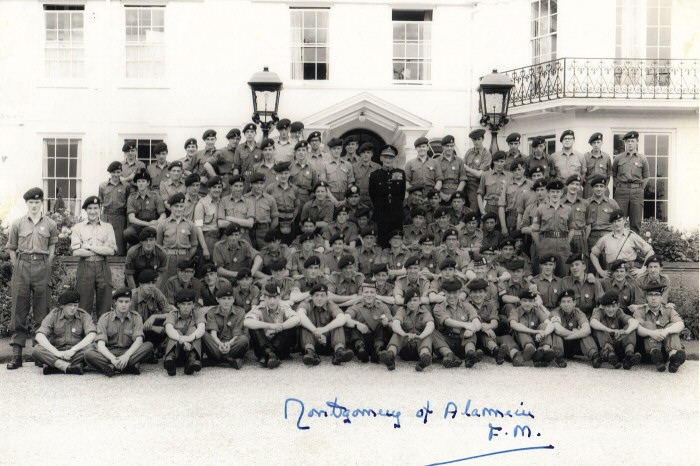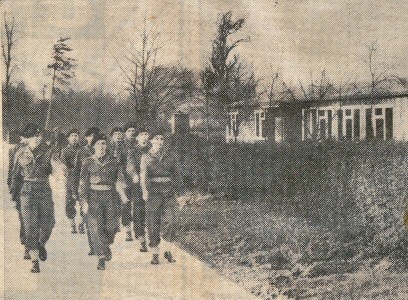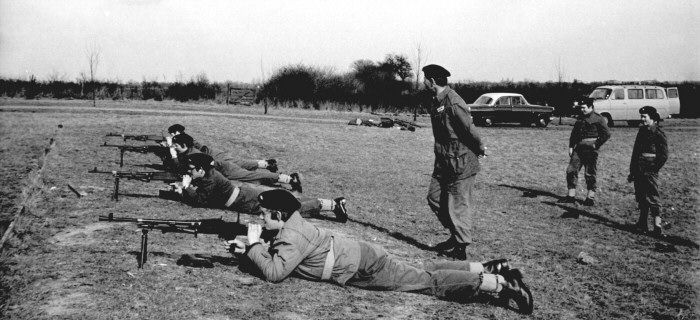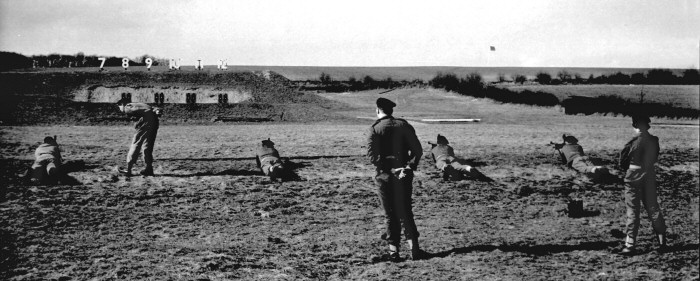If you have the Spring issues of the Soham Grammarian for 1965-68 please contact the editor
ACF NOTESfrom the Soham Grammarian, Spring 1963 The School ACF detachment was established in July 1962, forming a fourth company of the fourth Battalion, the Suffolk and Cambridgeshire Regiment. The cadets who were enrolled at the beginning of the 1962-1963 school year divided into four training squads. There was a tentative hope that the Senior squad, pre-selected according to age, ability and aptitude, would be ready to take the Certificate A part 1 Examination by February 1963. Lack of equipment, uniform and military precedent, as well as parade ground, were weighty problems during initial training, yet by November all cadets wore khaki and with the assistance of instructions from the parent regiment, proficiency and confidence improved. |
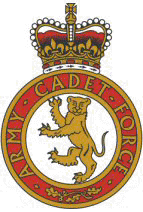 |
Training progressed so smoothly that it was decided early in 1963 to enter all cadets for the Part 1 Examination in February. The result was most satisfactory, with 52 out of a total of 70 obtaining passes with credit, and the remaining 18 cadets also obtaining good passes in the four branches of training - weapon training, fieldcraft, map reading and drill. The NCOs and cadets now pass on to more advanced work.
There are forty-five cadets attending Summer Camp at Penhale (Cornwall) and most cadets will be attending one of the two week-end courses arranged for the Summer Term.
I wish to place on record my thanks to Lt
Scott and to other members of staff, the officers of the
Suffolk and Cambs Regt (TA) and to the senior cadets (now
NCOs) of this company for their advice and assistance in the
difficult formative stage of this new venture.
Lt JGS
ACF NOTES
from the Soham Grammarian, Summer 1963
Throughout the term formal training for the Certificate A, part II examination has proceeded, under the experienced eyes of RSM Charlesworth and his experts from Ipswich. There have also been periods of more hectic "extra-mural" activities.
The weekend of 25th and 26th May saw 28 NCOs and Cadets on Kelling Health, near the Norfolk coast, undergoing a rigorous and action-packed exercise. This provided useful experience for those going to annual camp and all potential NCOs. The 4 sections, ably led by L/Cpls Butcher, Day TR, Scott and Shalders, were entirely self-supporting throughout the stay.
Our Annual Inspection by the affiliated Formation Commander, Brigadier N StG Gribben, OBE, and the County Cadet Commandant, Colonel JGA. Beckett, OBE, was the highlight of the year. After an inspection of normal training, and the customary march-past, the inspecting Officer expressed his satisfaction in the rapid progress that had been made and hoped that very shortly more training facilities would be made available to the Company.
Over the Whitsun weekend 27 cadets fired the Empire Test on the Battalion .22 Range at Cambridge. Of this total 13 achieved Marksman class, 9 First class and 4 Second class. L/Cpl Register RP, put up the best performance obtaining 78 marks out of a total possible of 80.
In the Inter-Battalion Athletics Championship, on 19th May, L/Cpls Butcher, Coe and Chapman and Cadet Pearson represented the 4th Battalion and acquired a total of 8 medals. L/Cpls Butcher and Coe have been selected to represent the Cambridgeshire ACF in the National Athletics Championship at Nuneaton an 6th July.
Another weekend exercise is planned to take place in July and also a visit to the Army PT School at Aldershot.
Cpl Poole has been awarded the NCO's Prize for the year, with Cpl Reynolds and Cpl. Docherty being close rivals. All three are to be commended for the fine example of enthusiasm and smartness they have so consistently set to the other NCO's and Cadets. Competition for the Cadet Prize, awarded to Cadet Bailey, was even keener; Cadets Markwell, Burtt, Petty, Holbrow, Walker, Lloyd and McMillan were worthy contestants, and all should make able NCOs.
It is hoped that next term will see the arrival of the
cadet hut and .22 range, and more equipment, which is so
badly needed. Cadets will take Cert A, Pt II examination, and
then pass on to leadership and adventure training.
JGS, Officer Commanding
ACF WEEKEND EXERCISE
from the Soham Grammarian, Summer 1963
On May 25th a contingent of about thirty Cadets, accompanied by Captain Speed and Lieutenant Scott, took part in the first of two weekend exercises. The Cadets were picked up by coach and after rifles had been collected from the school armoury the coach was bursting at its seams with cases, bags, haversacks, rifles, and of course Cadets. During the journey the air was filled with the crunching of apples, while a smell of fish paste pervaded the coach.
The coach approached the training area and the tension mounted as each Cadet impatiently gripped his rifle. When the coach had stopped, we all tumbled out to find that we had reached Melton Constable Railway station. It was identified, through the over-grown condition of the place, as being disused. Here the equipment, which fortunately had been packed in the boot of the coach, was allotted to the sections under the leadership of Shalders, Scott, Day, and Butcher. Each section had to carry a first-aid kit, two entrenching tools, one compass, and several lengths of rope, but fortunately for most of us the ground-sheets and blankets were put back into the coach again.
We all climbed aboard the coach again and each section in turn was dropped at a selected map reference and set out into the unknown. Using the maps and compasses we were told to cross-country to the rendezvous, avoiding people, roads, and buildings as much as possible. The rendezvous area was a clearing in a very shady rhododendron wood and in no time the area was covered with bivouac tents; smoke was soon rising from the roaring campfires cooking such delicacies as steak and kidney puddings, soup, creamed-rice and other mouth-watering delectables.
After the meal the section leaders were briefed for the first phase of the exercise - OPERATION SEEKIT. We cast off our battle dress and donned our denims and various forms of camouflage. This exercise began at 10 o'clock and for two of the sections ended at 11 o'clock; at midnight the third trudged wearily into the camp long after the others were sound asleep.
Next morning at about 5 o'clock the camp was a hive of activities, as Cadets awake and breakfasts were cooked. After breakfast the tent-pegs were ripped out and the camp sites restored to order. Then the most exciting and exhausting part of the weekend took place. Butcher's section was detailed as bandits, and had to conceal themselves in a large stretch of open heathland with a small area of woodland. The searchers swept across the area with its short prickly gorse, shrivelled by the sun which beat dawn constantly. This exercise proved very gruelling for all, especially the bandits, who had to lie concealed in their hideouts under a merciless sun for two hours. Afterwards we were rewarded by a swim in the chilly sea.
In the afternoon the last phase was executed - OPERATION CROSSIT. The sections converged on the River Glaven and at different points, without using man-made crossings or fords, crossed the river. Parts of the river contained a few feet of mud, and at least one cadet had to be extracted from the clinging mud by ropes, but most sections were very successful. We all then met the coach, and returned home via Newmarket and Soham.
This exercise must be considered a great success, and if
the next one goes as well the cadets will thoroughly enjoy
themselves. Thanks and appreciation must be given to Captain
Speed and Lieutenant Scott, and to the two Sergeants, Clarke
and Badcock, who accompanied us.
L/Cpl MDB
ACF NOTES
from the Soham Grammarian, Spring 1964
Although only at the half-way stage of its second year the Company has made rapid progress particularly since September, 1963, when the new basic intake from the Fifth Forms filled the gaps in the ranks which appeared at the end of the Summer Term.
The pioneers of that first year had possibly a harder task than their successors in moulding the image of this detachment to the parent Battalion and to the remainder of the School. Many of us will remember the strident voice of Cpl Reynolds on the Drill Square, the business-like efficiency of Cpl Docherty in the office and Cpl Poole in the Armoury, and others who contributed so much.
They missed some of the fruits of their labour in that of the thirty-seven who remained, all passed Certificate "A", part 2, twenty-three with credit, albeit with some difficulty and intensive preparation, and these now form a core of well-informed NCOs and Cadets essential to the well-being of any cadet detachment. Having cleared the examination hurdles these senior NCOs and Cadets are now taking part in an Instructors' Cadre, an intensive teacher training course. Armed with copious notes and "Lesson Plan Cards" they are beginning to understand some of the problems of class management and "chalk and talk" which face the professional specialists on the other 4½ days of the week.
The newer cadets studied for the Certificate "A", part 1 Examination which was taken on 14th February, and in which of the 37 cadets who were tested all passed, 20 with credit.
The Cadet Hut, so long the CO's pipe dream, has materialized on its first proposed site, and each room is now used by different branches of the hierarchy. It is hoped that the stark interior will be improved before the Summer Term. The administration of the Office, Stores and Armoury has been streamlined. Credit must be given to Cpls Ball, Smith, Strevens and Shalders for the mature and enthusiastic manner in which they have accepted their responsibilities.
This School Year has also seen the formation of a representative Cadet Committee, cadets learning to play instruments under the experienced guidance of Mr. Talbot, and a highly successful "season" for the footballers. No less than ten NCO's and cadets, with two reserves, represented this Company in the Cambridgeshire and Isle of Ely ACF Brigade Team, and have reached the final of the Eastern Command Cup Competition.
In many ways this School Year for the Cadet
Company has been, so far, one of consolidation and gradual
extension, with training following a familiar pattern. Plans
have been formulated to add more vitality to the training
programme through adventure training weeks, week-end courses
and Range shooting.
JGS, OC
SUMMER CAMP, 1963 - BATTLE OF BODMIN MOOR
from the Soham Grammarian, Spring 1964
I awoke; the dirty cream-painted ceiling was only a few inches from my face. Then I remembered where I was - lying on a greatcoat-covered luggage-rack. In the opposite rack lay Cdt Griffiths, below me were the sleeping, wheezing, snoring forms of L/Cpl Day and Cdts Rae, Bond and Bailey. Filling in the gaps between the khaki bodies were clumps of webbing, haversacks, greatcoats, suitcases and half-eaten sandwiches.
The journey had started for the Soham Contingent at Ely Station, where we encountered a barrage of abuse from the whole of the 3rd Btl. We returned small arms fire while L/Cpl. Day fired a hasty salvo of colourful, rural expletives. At 21.00 hrs reinforcements arrived when the remainder of the 4th Btl entrained at Cambridge. Gradually sounds of battle died away and the train slept fitfully.
The train arrived next morning at St Austell, Cornwall, at 10.00 hrs where the entire two Battalions detrained and were ordered into waiting transport which completed the journey to Penhale Camp, near Newquay. The tired, yawning ranks were swiftly divided into their two Battalions, each of which was organised into two Companies, each Company sub-divided into five Platoons, and each Platoon split into three Sections. The remainder of the day was spent in drawing stores - rifles, blankets, mess-tins, ground-sheets, bivouacs, packs and spades.
Early next morning most cadets were awoken by an Orderly Sergeant lifting the foot of their beds two feet and dropping them onto the concrete floor of the hut. By 09.00 all Platoons were drawn up in heavy battle order with rifles. The Motor Transport was loaded with all the stores and the platoons entrucked; by 10.00 we moved off in convoy towards Bodmin Moor.
When the Moor was reached, the convoy split up, and all personnel de-trucked and took up defensive positions, whilst drivers threw camouflage nets over their vehicles. In half an hour, as dusk was falling, bivouacs were erected on an old rifle-range, food cooked and sentries detailed. The cold night passed slowly - only the drifting, motley forms of changing sentries broke the deep blue silence of the Cornish summer night.
Camp was broken at 08.00, and after six miles on foot across low moorland in blazing sun the objective was reached and the battalion crossed a two hundred yard lake in assault boats to take up defensive positions on the far bank. During the late afternoon, as the "Defended Area" was being prepared, an enemy section was seen advancing through the gorse. The spotting of more enemy troops suggested that an attack on battalion level was forming, so a runner was sent to Coy HQ and two HQ Platoons were rushed up to reinforce our position. The sight of some forty rifle-wielding cadets advancing at the double proved too much for the attackers and the assault was quickly parried.
During the night double sentries were posted; Cdt Griffiths challenged a wandering horse, while L/Cpl. Shalders, in the half-light of dawn, mistook a group of black-faced sheep for an enemy section and alerted the platoon. The most interesting part of the exercise was to come. It was known that the enemy, 3rd Battalion, were somewhere on the moor and it was required that 4th Battalion should close with them and win a tactical victory. Once on the moor, the platoons took up positions relayed to Platoon Commanders by signallers labouring under their heavy W/T packs - and waited. For nearly an hour we lay in the grinding heat of the sun. Then in-coming reconnaissance patrols were spotted on the distant horizon - they reported that the two enemy Companies were advancing down a rock strewn valley some 2½-3 miles to the NE of our position.
After advancing and halting for two hours across the rocky hills and sticky, warm bogs we halted at the edge of a deep ravine, on the other side of which rose a large, almost spherical hill. Round the far edge of the ravine a platoon was in position facing up hill defending the ravine which offered a quick escape route to a beaten enemy. We crossed the ravine and advanced through the defending platoon and continued up the never-ending hill in arrowhead formation. On our left was another platoon advancing with us; a mile to our right on a distant hillside three platoons of "A" Company 4th Battalion were rapidly approaching our objective. Four hundred yards to our right another "A" Company Platoon was toiling up the hill endeavouring to join us before the final assault; behind us lay the reserve platoon in a strong position.
When the order was given, with the crash of thunder flashes echoing round the hills and the sharp clatter of blanks in the smoke-laden air, we charged through the enemy lines, swinging and avoiding rifle butts and reformed fifty yards behind the shattered enemy ranks. In true cadet traditions both battalions claimed to be the victors but tactically 3rd Battalion were completely outpositioned, outnumbered and unorganised.
All personnel returned to camp to remove sweat-stained greasy denims, and chafing webbing, soak aching feet, and to clean boots and blanco equipment for the following day's parade. A lesser "battle" occurred a day later on the clifftops but just as the action started a carelessly thrown thunder-flash set fire to the grass and a halt had to be called in order to put out the conflagration.
The remainder of the camp passed quietly ; Battalion colours were marched past and cups were presented. Stores were returned and every article checked and packed in the MT for the return journey. The two battalions, still arguing about the "punch up", returned home and peace descended on Bodmin Moor. I returned lighter in pocket and weight but darker in colour and with much valuable experience in organisation.
Non-ACF Fifth and Sixth Formers may deride
the seemingly top-heavy administration and the typed pages of
military jargon on the notice-board but the system really
showed its efficiency during Summer Camp, when everything
moved extremely smoothly; no mean feat when one considers the
task of organising the stores, orders, transport, catering
formations, discipline, billeting and entertainment of five
hundred cadets.
Cpl PCS [Peter Shalders]
ACF NOTES
from the Soham Grammarian, Summer 1964
The experienced assistance the company received from the parent regiment, the Suffolk and Cambridgeshire, has been temporarily halted this term and instruction of the Certificate A syllabus has been largely in the hands of the senior NCO instructors. These were split into four instructor squads and, ably led by Sgts. Shalders, Ball, Smith and Cpl Scott; they devised their own programme of instruction and gave lessons of a good standard.
Sgt Shalders started the term well by receiving an outstanding grade in the Eastern Command leadership course which he attended during the Easter holidays. At the same time, twenty NCOs and cadets, accompanied by the CO, went to Blenheim Camp, East Anglian Brigade HQ, Bury St. Edmunds. Despite an overcast sky and sub-normal temperatures this first Easter camp was generally enjoyed.
The Platt Memorial Prize for cadets of one year's service was awarded to Cadet Porter. L/Cpl Parkinson must also be congratulated for gaining his first stripe within one year, a promotion he thoroughly deserved. The prize for the Cadet of the Year was awarded to Sgt Shalders who has always shown enthusiasm and drive, and has obtained a place at the Royal Military Academy, Sandhurst. We all wish him well.
The second annual inspection of the Company was undertaken by Major JLR Brashaw of 151 Infantry Brigade, Colchester, accompanied by the County Cadet Commandant, Colonel JGA Beckett, OBE. After inspecting Cadets on the Parade Ground, the inspecting officer saw cadets undergoing normal training, and inspected the Armoury and accommodation. After the March Past he expressed satisfaction in the rapid progress that had been made since the formation of the Company, less than two years ago.
Work is now progressing in preparation for the School Open Day. The Hut is being painted, the miniature range nears completion and plans are well advanced for the Assault Course.
Many NCOs and cadets are leaving at the end of the term;
to them, and to those who will be returning, I would like to
express my thanks for their efforts in the various
departments of the Company throughout the school year.
JGS, Officer Commanding
Cambridgeshire Times June 25th 1964
SOHAM GS CADETS INSPECTED
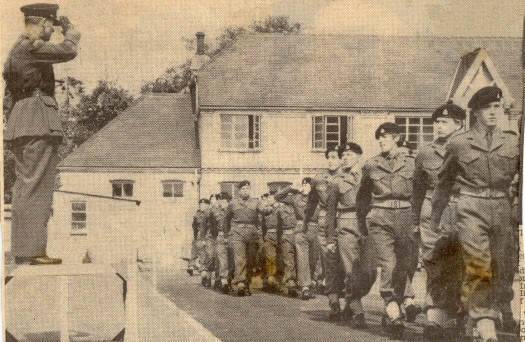
The annual inspection of Soham Grammar School Army Cadet Force Detachment, No.4 Coy of 4(C) Bn., the Suffolk and Cambridgeshire Regiment, was held on Friday afternoon.
Major JLR Brashaw, of 151 Infantry Brigade, conducted the inspection and was accompanied by Col JGA Beckett (County Cadet Commandant).
After inspecting the detachment on the parade ground, Major Brashaw watched NCOs and Cadets undergoing normal training as on parade days. NCO instructors taught lessons, both indoor and outdoor, on various aspects of the Certificate A syllabus.
Two periods of intensive training were followed by the ceremonial march-past and the inspecting officer then addressed the company.
He expressed satisfaction both with the general smartness and the excellent turnout of the individual NCOs and Cadets, and was impressed by the rapid progress the company had made in under two years since its formation.
Major Brashaw congratulated Captain JG Speed (Commanding Officer) and 2nd Lieutenant PD Scott (Second-in-Command) on the organisation and running of the detachment, and expressed the hope that the company would be able to hold field days during the next school year.
He also saw construction work beginning an the new indoor .22 rifle range, and with Col Beckett was informed of Cadet projects for the school Open Day on July 18th.
ACF NOTES
from the Soham Grammarian, Summer 1965
The Range came into full use during this third year and the Company welcomed Flight Lt Callan, of Downham Market ATC, whose assistance, particularly in organising shooting and being CO of the Range, has been invaluable. During most parades he has coached the cadets in the long mushroom shed and the fact that a team came sixth in a field of two hundred and sixty teams in a nationwide small bore competition and won the County Shooting Trophy is, in large measure, a result of the interest he has brought to this new department.
Sgt Capes, Sgt Herod, Cpl Ellis, L/Cpl Webster, L/Cpl Harper, Cdt. Benson and Skae composed the formidable team which recorded the highest total marks in the Robinson Trophy Competition since the first shot was fired in 1946. Equally successful on the games field was the football team of Sgt Burtt, Cpl Porter, Cpl Green, L/Cpl Dunham, L/Cpl Peachey, L/Cpl Pearson, L/Cpl Harper and Cdts Impey, Newell, and Fretwell, which, captained by Sgt Butcher, won the Eastern Command Cup for Cambridgeshire for the third successive season. Mr. Taylor must be thanked for having coached them, albeit for different opponents, and also Cpl Day, the reserve, for travelling regularly throughout South-East England without playing in a single game.
Cadet Bailey came back from the Brigade Swimming Championships with three winner's medals and Sgt Butcher, Cpl Green and L/Cpl. Anderson have all been selected to run at the ACF National Athletics Championship at Taunton, Somerset.
An unspectacular, yet the most worthy achievement of the year, was in winning the Bishop of Ely Shield awarded to the most efficient detachment in Cambridgeshire and the Isle of Ely. It is hoped that this shield will be at Soham for many years.
The Certificate A examinations held in the Spring Term were successful, all cadets passing the Part I examination, some after a second attempt, and all but one passing the Part II examination. The NCOs responsible for the instruction of the very raw first year material had every reason to be pleased with the result. This NCO instruction was a new experiment which worked well and will be perpetuated. RSM Parrott and the PSIs guided the sixth form NCOs and cadets through the more difficult second examination and then pursued a more advanced training course during the Summer Term. The junior NCOs are now ready for more responsible work in instruction and company administration.
Following the Annual Inspection on what has since proved to be the hottest day of a sunless summer, we were pleased to welcome Major SC Aston, Chairman of the County Cadet Committee to the senior Prizegiving ceremony, who came, at the Headmaster's invitation, to present the ACF awards and certificates. He was accompanied by Col B McCall, the Secretary of the County Territorial Association, who, like Major Aston, has taken a keen interest in the Soham ACF detachment.
A good sign this year is that more senior NCOs are attending outside courses. These provide an excellent training coupled with good accommodation and are thoroughly recommended to all new NCOs. Sgt Capes and Cpl Green were first away this year, journeying to Colchester to partake in a strenuous PT course; Sgt Fitch and Sgt Butcher, shortly afterwards went on a First Aid Course, although any apparent relationship between these courses is purely coincidental. At Easter, Sgt Butcher and Sgt Capes, emulating the Shalders of last year, attended the strenuous Eastern Command Senior NCOs Leadership Course and in the fortnight appeared on Anglia Television. To get a place on this course is the most coveted privilege in cadet circles, only 2 places being allocated to each County. Cpl Green goes this summer to an NCOs leadership course and 12 NCOs and cadets accompany Lt Scott, the CO designate, to annual training at Leek, Staffs.
A worthwhile liaison has been established with Fordham detachment and Sgt Capes, Sgt Fitch, Cpl Ellis, L/Cpl Bray and L/Cpl Griggs assist in training there. Both Sgt Capes and Sgt Herod must be congratulated on gaining the rank of adult Sergeant instructor to work with other detachments in the County.
To the thirty NCOs and cadets who are leaving I would like
to say thank you for a job well done, to thank also the
Headmaster for his wonderful support and to wish my
successor, Mr Scott, and the Company, good luck for future
years.
JGS, Officer Commanding
source not stated, 3 April 1965
Soham
G. S. cadets champions again
|
| Cambridgeshire Army Cadet Force, whose team consisted entirely of boys from Soham Grammar School won the Eastern Command Cup for the third successive year by defeating Suffolk 3-1 in Sunday's final on the R.A.F. Hospital ground, Ely. In earlier rounds they had accounted for Herts. and Norfolk. The team in our picture is (left to right) - right-back Richard Peachey, outside-right Terry Impey, left-half Julian Harper, outside-left Richard Pearson, right-half and skipper Norman Butcher, inside-right Johnny Fretwell, centre-forward "Bud" Green, goalkeeper Stewart [sic] Porter, centre-half David Burtt, inside-left Lester Newell and left-back Paul Dunham. Scorers were Green (2) and Newell. (Photo: Ray Jefferson, Littleport). |
ACF NOTES
from the Soham Grammarian, Summer 1966
The absence of a third year sixth form this year has caused a much heavier burden to fall upon the four sergeants of the Company, all drawn from the second year sixth. The smooth running of the Company has been largely the result of their enthusiasm and efficiency and the high pass rate in the Certificate "A" examinations bears witness to the capability of their instruction.
The shooting team was this year placed third in the Robinson Trophy; it is hoped that next year we shall be able to overcome the increased competition within the Brigade. The Company again provided the greater part of the Battalion football team and also sent a strong team to compete in the Inter-Battalion and Eastern Command Athletics Championships.
Sgt Green, Sgt Porter and Cpl Anderson are to represent the County in the ACF National Athletics Finals in Leeds.
Cpl Bray and Cpl Gray are to attend the Senior NCOs Leadership Course at Frimley Park in the summer; we have found this course to be of great value to potential Senior NCOs.
On 8th July the Company was inspected by Capt Woods who,
at short notice, took the place of Major Starling who was
unable to attend. We much appreciated Capt Woods filling the
breach and his helpful comments during the course of the
inspection.
PDS, CAPTAIN, OFFICER COMMANDING

